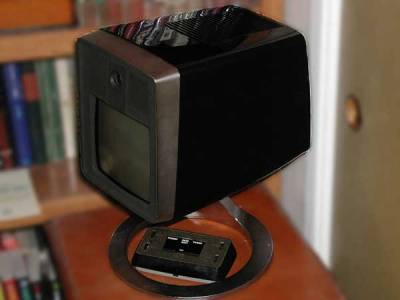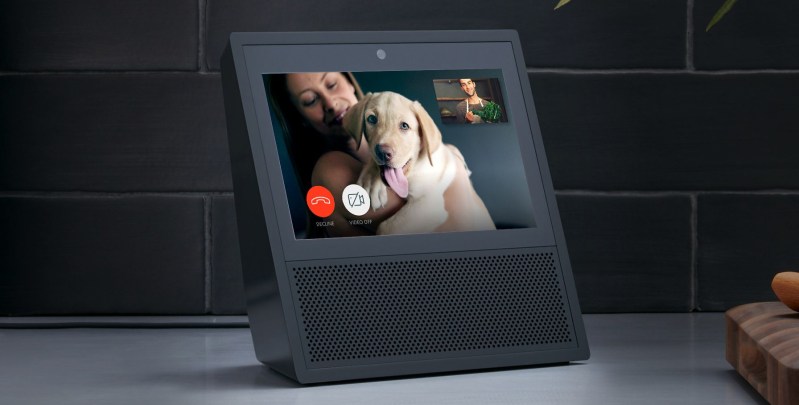Back in May, Amazon announced the Echo Show, its new version of Alexa with a 7 inch touchscreen. The Echo Show is an interesting device, but will the great unwashed masses pony up $229 to buy the show? That’s $50 more than the original Echo, or $180 more than the Echo Dot. With 5.2 million units sold in 2016, Echo has been a resounding success. This has been in part due to Amazon’s open approach to the API. Anyone can build an Alexa compatible device using a Raspberry Pi. Google has (finally) followed suit with their Home device.
It’s not just the hardware that is accessible. Skills Kit, the programmer interface for extending Echo’s functionality, is also open. At CES this year, Alexa was the belle of the ball. Third party devices are being introduced from all corners, all of them connecting to Amazon’s cloud and responding to the “Alexa” keyword.
The Echo Show takes the family in a new direction. Adding a touch screen gives the user a window on the the world not available with voice interactions. Echo Show also includes a camera, which opens up a whole new set of privacy and security questions. Amazon touts it as a device for viewing security cameras, watching YouTube videos, and making video calls. This puts Echo Show dangerously close to the internet appliance category, essentially a barren wasteland littered with the corpses of previous devices. Does anyone remember when Palm tried this with the 3Com Ergo Audrey? How about the i-Opener? Will Alexa persevere and succeed where others have failed? A lot of it will depend on the third party developers, and how Amazon treats them.
Looks Who’s Calling
The feature Amazon is pushing hardest is video calling. Their promo videos have grandmothers calling in to say hi to their kids, a mother calling from the road, and a grandfather showing off a mural he created with his young granddaughter. But does anyone want a table-top video conferencing device in their home?
 Hardwired videophones have been a promised future technology since the 1870’s. The history of the device closely follows that of the television, as early videophones were simply two CCTV systems setup for full duplex communications. A system like this connected post offices in major German cities between 1936 and 1940. Bell labs worked on the problems for decades. The result of their work was the AT&T picturephone, demonstrated at the 1964 New York World’s Fair, and released to market in 1970. The picturephone used specialized phone lines and required a bandwidth of 6.3 Mbps for full duplex video and audio. The device cost $500 million to produce and was a commercial flop. To quote AT&T historian Sheldon Hochheiser, videophones are ”the most famous failure in the history of the Bell system.”
Hardwired videophones have been a promised future technology since the 1870’s. The history of the device closely follows that of the television, as early videophones were simply two CCTV systems setup for full duplex communications. A system like this connected post offices in major German cities between 1936 and 1940. Bell labs worked on the problems for decades. The result of their work was the AT&T picturephone, demonstrated at the 1964 New York World’s Fair, and released to market in 1970. The picturephone used specialized phone lines and required a bandwidth of 6.3 Mbps for full duplex video and audio. The device cost $500 million to produce and was a commercial flop. To quote AT&T historian Sheldon Hochheiser, videophones are ”the most famous failure in the history of the Bell system.”
AT&T tried again and again to make a business of video telephony. Their final attempt was in 1992 with the Videophone 2500, a digital device which used a modem to send color video over standard phone lines. The tiny onboard LCD and low quality video, along with an introductory price of $1500 doomed this product to failure as well.
Stand alone videophones have done pretty well in the business market. Companies like Polycom, Zoom, and Avaya make expensive systems for corporate meeting rooms. These tend to be multi-camera systems with multi-thousand dollar price. However, video phones never quite broke into the home. Video telephony is doing great of course — everyone seems to be using Facetime, Google Hangouts, or Microsoft’s Skype. But these services are generally used from mobile devices – phones, tablets and laptops. There aren’t many people buying Skype video phones for their homes.
The same argument holds for YouTube videos. For better or for worse, much of humanity has become a society of information grazers. Carrying our phones and phablets with us, pulling information down as we need it. In the kitchen, the backyard, the garage, and even the bathroom. With these multifunction information portals at our fingertips, there isn’t much need for a tabletop device to view videos.
Roll Your Own Interface
What do people want from an always on 7 inch LCD? It’s not Wang Chung Lyrics. But right here on the pages of Hackaday we’ve seen plenty of applications. Pi powered magic mirrors have been popping up for the last few years.
Just as with the original Echo, Amazon is going to create a community and let 3rd parties as well as end users build the applications — using their Skills framework. Working with devices that have a screen as well as a camera is a bit more difficult than the query/response system used for voice. It seems that Amazon has been working on this though. At CES back in January, they debuted Display Cards for Alexa, a way of displaying information along with voice responses. Austensibly this was designed for the nucleus intercom and Fire TV products, but it’s not a far leap to guess that Amazon already had Echo Show in the pipeline with this software.
Echo will be based upon these cards. But there will also be “GUI templates” for developers to use. However, beyond a blog post announcing this, here hasn’t been much in the way of public information on how Amazon is going to open the Echo Show for developers. Sure, there is a sign-up email link, but nothing hard yet.
So will the Echo Show be a hit as big as the original Alexa? Or are we looking at the Fire Phone 2.0? It’s all going to depend on hackers like us, and how well Amazon enables us to crank out cool skills for the device.
















“Stand alone videophones have done pretty well in the business market. Companies like Polycom, Zoom, and Avaya make expensive systems for corporate meeting rooms. These tend to be multi-camera systems with multi-thousand dollar price.”
Considering how much it costs to ship people around, yeah.
There is one thing about video calling to keep in mind. Appearance, as in the callers. Vanity demands it.
Would you mind speaking in complete and reasonable sentences?
The biggest issue with Alexa’s interface is not knowing what the limits of her understanding are. A bit of visual feedback around the options available for an interaction will be a big help. e.g. “Alexa turn the kitchen lights on”. “I’ve found several devices of that name”. “Alexa, TURN the K-I-T-C-H-E-N LIGHT ON”. “I’ve found severals devices of that name”. Ad nauseam.
Or “Is it going to rain today” — Alexa show: “I don’t think so, here’s the weather radar for the afternoon”.
“Alexa, **** off.” – “I’ve found no devices of that name.”
Will the screen give a better answer?
Also, the new device can be used to watch YouTube.
“Alexa, do you like PewDiePie?” – “You’re now subscribed to PewDiePie”.
One more reason to hate him.
Tell it this “Alexa begin auto destruct sequence authorization Bezos 4 7 alpha tango.”
I’m pretty sure nothing bad will happen.
My prediction: Guaranteed hit. Just the upgrade Alexa needed. Imagine cooking in the kitchen and wanting a recipe demonstration. Or, catching the latest Episode of a streamed Amazon show. Adding a screen is genius!
Puppies!
This almost looks like the Pi-Top Ceed.
This is just tech product news. There are tons of sites for that already where people go specifically for that kind of thing. Why should Hackaday try to compete in that space?
In short, “not a hack.”
Yes, click-bait wittering with no real substance, pending the formal release next week — presumably in the hope of bumping up hits when people start searching for more info. How I wish HaD would separate editorial. opinion pieces and hacking articles more clearly. (Something like The Register’s homepage would be a reasonable model).
Look for the little green “Featured” tag in the upper-left of the article’s image. Most of our original pieces have it — sometimes we mess up. Skip those at your peril, though. Sometimes we cover our own hacks. [Adil]’s FPGA-LCD-to-VGA adapter last week was pretty awesome, for instance.
But on this one, I don’t think the title “Amazon Echo Show” is very deceptive for a piece about the Amazon Echo Show.
“Not a hack”. Yup. But maybe a device that will launch some cool hacks? Or maybe not. That’s up to y’all.
If it becomes ubiquitous enough video calling might actually become a thing after all these decades?
I see this more as a “new part day” type post. I would have appreciated more discussion of hackability and less discussion of marketability though.
>Palm tried this with the 3Com Ergo Audrey? How about the i-Opener
or Linux powered Amstrad’s E3 videophone, and it was 2x cheaper.
>Their promo videos have grandmothers calling in to say hi to their kids
like this?
https://www.youtube.com/watch?v=jcl9zP2o_Dk
I’m more interested in the new Dash Wand. At $20 i’m hoping there’ll be someone smarter will find an interesting hack with it…
I still don’t understand why anyone would buy an Alexa device instead of talk to the phone they’ve already got in their pocket with Siri / google’s thing.
I wondered that same thing, when I first saw these doo-dads.
Probably comes down to this search phrase.
“smartphone sales flattening?” dropped into Google.
Call me a cynic, but it just looks like more market churn and an attempted grab for a slice of the phone market that’s displacing most other communication gadgets.
Yes, and why do we need yet another screen?
Have smart phone. Photo frame. Laptop. TV.
Now if they could make it use whatever screen I happen to be looking at/using.
(Or even select which screen I want it to respond with.)
We can’t use that screen, it was made by somebody else??
Dunno about Alexa. But Siri is not to be trusted.
Funny how when we were finally given a video capable phone, we use it for mostly texting(cough,email).
Maybe amazon sees a drift towards that desktop style useage as being trendable?
Since almost no one actually wants to talk to or much less see the other person, in real time….?
Seems the main use of the smart-or-video phones video/photo capabilty has drifted towards posting general evidence of ones own foolhardy or illegal endevours.
Not to forget the interspersed sociopathic things that get posted to “social” media.
Does anyone know if we can pump echo show onto a larger display somehow?
I would like to have the ability to send my Alexa Shows video to my TV as well, I was quite surprised to find that is not a native option, Seems so logical to do so. I know several people who would have purchased one as well after I did if it only had this one simple ability. Seems Amazon often misses the obvious features people really want. I would settle for a hack if one is available, even if I have to go with cutting and patching wires and soldering to have it. Any one have instructions?